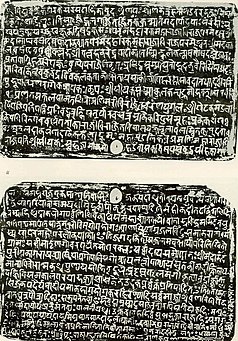Harsola copper plates
The origin of the Rajputs has been one of the most speculated topic in Indian history. The Harsola copperplate grants of 949 CE are one of the most important documents that shed light on origin of the Paramara dynasty,[1] and hence on the origin of Rajputs.[2] They establish that
- The Paramaras started out as feudatory of the Rashtrakutas of Manyakheta.[3]
- They belonged to the same "kula" (family) as the Rashtrakutas.
This establishes that the legend of the agni-kunda origin [4] came much later.


The beautifully incised Garuda image in human form with wings on the grants, is considered to be the earlier form of drawing which came to be known as the Jain style as used in Jain manuscripts.[5][6]
The Grants
The Harsola copperplate grants were found at Harsola in district Ahmedabad in Gujarat.[7] This is a pair of grants, each engraved on two plates.
- Grant A: grant to father
- Grant B: grant to son
The early parts of the text in the two grants is identical, although the two grants were obviously engraved in different hands. Apparently the grants were linked by a ring, with the royal seal (garuda) at the end of Grant A, which was placed after B.
The Text
In this pair of grants, the first verse after the opening Siddham invokes blessings of vishnu in form of Vaharaha (sukhayantu vah.. etc.). The second verse first mentions the sovereign king (lines 3-4):[8]
parama-bhattaraka maharadhiraja (etc.) Akalavarsha, with titles prathvivallabha-shrivallabha, who had learned at the feet of parma- bhattaraka (etc.) Amoghavarsha,
Later in lines 5 and 6 it mentions:
... in his family was born, vappiyaraja (so named) king (nrapa), following him his son Vairisimha..
Later it in line 8, it mentions Siyaka in this family (tasmin kule.. jaatah ). Further (lines 11,12,13) it mentions for the same Siyaka,
mahamandalika-chudamani- ..shri-siyakah-bhujyaman ..kumbharotaka- grama ..
Here is explicitly mentions Siyaka as a mandalika (i.e. a feudatory) and a village in his domain. Note that Parama-bhattarka indicates a sovereign king, who is not under a higher king.
The complete text can be seen in the reference below.
Paramara Chronology:
Through Parmar copper-plates, the genealogies given in Navasahasanka- charita and the Udaipur prashasti, the following genealogy can be constructed for early Paramaras, along with estimated period:
- Upendra
- Bappairaja/Vakpatiraja/Krishnaraja [895-920]
- Vairisimha [920-945]
- Siyaka/Harsha/Simha [945-973]
- Vakpati/Munja [973-995]
- Sindhuraj/Navasahasanka [995-1000]
- Bhojadeva [1000-1055] the best known king of the dynasty
The name of Upendra is not given in any of the copperplates, but is mentioned in Navasahasanka-charita, where he is said to have performed many sacrifices. He is mentioned there as the founder of the Paramar house. He is the first historic person of the Paramar clan. If the agni-kunda sacrifice corresponds to something historical, it must be the sacrifices conducted by Upendra.
Parmaras had several branches, the best known of them is the Malava branch (above). It was Siyaka who was mainly responsible for establishment of the Malava branch. Other branches were located at Chandravati (records of 1043-1287), Vagad (records of 1059-1109), Bhinamal (records of 1012-1183) and Jalor (a record of 1118), all of them in the vicinity of Abu. The last record of the Malava branch of Jaivarman/Jaisimha is dated to 1274. It appears that a minister of the Parmaaras, Koka, took a large part of the kingdom from the last king of Malava, Bhoj II. Alauddin Khalji's general Einulmulk Multani, defeated Koka and captured Dhara and built a mosque there in 1311. A Bhoja, said to have been converted to Islam, must have been this Bhoja II.
References
- ^ The Paramāras, c. 800-1305 A.D., Pratipal Bhatia, 1970, p. 15
- ^ H.V. Trivedi, Editor, Inscriptions of the Paramaras, Chandellas, Kachchhapaghatas and two minor Dynasties", part 2 of the 3-part Vol III of Corpus Inscriptionum Indicarum, edited in 1974 by (published in 1991).
- ^ Rāshṭrakūṭas and their times, p. 120, Anant Sadashiv Altekar, 1967
- ^ Dhanapāla and His Times: A Socio-cultural Study Based Upon His Works,p 267, Ganga Prasad Yadava,1982
- ^ More Documents of Jaina Paintings and Gujarati Paintings of Sixteenth and Later Centuries, Umakant Premanand Shah, L. D. Institute of Indology, 1976, p.
- ^ Early Indian miniature paintings (c. 1000-1550 AD), p. 22, Rashmi Kala Agrawal, 2006
- ^ The dynastic history of northern India (early mediaeval period), Hem Chandra Ray, 1973p. 848
- ^ H.V. Trivedi, Editor, Inscriptions of the Paramaras, Chandellas, Kachchhapaghatas and two minor Dynasties", part 2 of the 3-part Vol III of Corpus Inscriptionum Indicarum, edited in 1974 by (published in 1991).
